Risk Assessment of Geological Hazards in Dawukou, Shizuishan City Based on the Information Value Model
Abstract
1. Introduction
2. Geological Context
2.1. Topographical and Geological Setting
2.2. Hydrology and Climatic Influences
2.3. Human Impact and Hazard Distribution
3. Methodology and Data Sources
3.1. Methodology
3.1.1. Information Value (IV) Model
3.1.2. Factor Selection and Weighting
3.1.3. Risk Zonation
3.1.4. Model Validation Methodology
3.2. Data Sources
3.2.1. Geological Data
3.2.2. Hydrological and Climatic Data
3.2.3. Environmental Data
3.2.4. Anthropogenic Data
3.2.5. Geological Hazard Records
3.3. Data Processing and Analysis
4. Results
4.1. Susceptibility Evaluation
4.1.1. Influence of Key Factors
4.1.2. Susceptibility Map
4.2. Risk Zone Mapping
- High-Risk Zone (1.55% of the area):
- Moderate-Risk Zone (10.16% of the area):
- Low-Risk Zone (23.32% of the area):
- Very-Low-Risk Zone (64.97% of the area):
4.3. Validation
5. Discussion
5.1. Effectiveness and Applicability of the Information Value Model
5.2. Implications for Risk Management and Mitigation
5.3. Challenges, Limitations, and Future Directions
6. Conclusions
- (1)
- Slope gradient, lithology, fault proximity, vegetation index (NDVI), and precipitation were identified as the primary factors influencing geological hazard susceptibility, with steep slopes and weak lithology being the most significant contributors.
- (2)
- The study delineated four risk levels (high, moderate, low, and very low). The high-risk zones were concentrated near mining areas, fault lines, and steep slopes, providing a clear spatial understanding of hazard distribution.
- (3)
- Targeted interventions, including slope stabilization, vegetation restoration, and real-time monitoring, are essential for high-risk areas while integrating hazard assessments into urban planning enhances resilience and safety.
- (4)
- The methodology provides a replicable approach for hazard assessment in similar regions, demonstrating the importance of combining quantitative modeling, dynamic environmental factors, and validation for comprehensive risk management.
- (5)
- The IV model enables a quantitative susceptibility analysis, where slope, lithology, and vegetation cover were identified as the most sensitive variables contributing to hazard occurrence.
Author Contributions
Funding
Institutional Review Board Statement
Informed Consent Statement
Data Availability Statement
Acknowledgments
Conflicts of Interest
References
- Alexander, D. Vulnerability to landslides. In Landslide Hazard and Risk; John Wiley & Sons Ltd.: Hoboken, NJ, USA, 2005; pp. 175–198. [Google Scholar]
- Del Ventisette, C.; Garfagnoli, F.; Ciampalini, A.; Battistini, A.; Gigli, G.; Moretti, S.; Casagli, N. An integrated approach to the study of catastrophic debris-flows: Geological hazard and human influence. Nat. Hazards Earth Syst. Sci. 2012, 12, 2907–2922. [Google Scholar] [CrossRef]
- Geertsema, M.; Highland, L.; Vaugeouis, L. Environmental impact of landslides. In Landslides–Disaster Risk Reduction; Springer: Berlin/Heidelberg, Germany, 2009; pp. 589–607. [Google Scholar]
- Glade, T.; Crozier, M.J. The nature of landslide hazard impact. In Landslide Hazard and Risk; John Wiley & Sons Ltd.: Hoboken, NJ, USA, 2005; pp. 41–74. [Google Scholar]
- Jakob, M. Landslides in a Changing Climate, Landslide Hazards, Risks, and Disasters; Elsevier: Amsterdam, The Netherlands, 2022; pp. 505–579. [Google Scholar]
- Mazzorana, B.; Picco, L.; Rainato, R.; Iroumé, A.; Ruiz-Villanueva, V.; Rojas, C.; Valdebenito, G.; Iribarren-Anacona, P.; Melnick, D. Cascading processes in a changing environment: Disturbances on fluvial ecosystems in Chile and implications for hazard and risk management. Sci. Total Environ. 2019, 655, 1089–1103. [Google Scholar] [CrossRef] [PubMed]
- Albahri, A.; Khaleel, Y.L.; Habeeb, M.A.; Ismael, R.D.; Hameed, Q.A.; Deveci, M.; Homod, R.Z.; Albahri, O.; Alamoodi, A.; Alzubaidi, L. A systematic review of trustworthy artificial intelligence applications in natural disasters. Comput. Electr. Eng. 2024, 118, 109409. [Google Scholar] [CrossRef]
- Cui, P.; Peng, J.; Shi, P.; Tang, H.; Ouyang, C.; Zou, Q.; Liu, L.; Li, C.; Lei, Y. Scientific challenges of research on natural hazards and disaster risk. Geogr. Sustain. 2021, 2, 216–223. [Google Scholar] [CrossRef]
- Tamilarasi, K.; Krishnakumar, P. Unravelling Complications in Natural Disasters: A Comprehensive Exploration, Predicting Natural Disasters With AI and Machine Learning; IGI Global: Hershey, PA, USA, 2024; pp. 1–40. [Google Scholar]
- Katyal, A.K.; Petrisor, I.G. Flood management strategies for a holistic sustainable development. Environ. Forensics 2011, 12, 206–218. [Google Scholar] [CrossRef]
- Dong, L.; Cao, J.; Liu, X. Recent developments in sea-level rise and its related geological disasters mitigation: A review. J. Mar. Sci. Eng. 2022, 10, 355. [Google Scholar] [CrossRef]
- Huang, Y.; Cheng, H. The impact of climate change on coastal geological disasters in southeastern China. Nat. Hazards 2013, 65, 377–390. [Google Scholar] [CrossRef]
- Tsatsaris, A.; Kalogeropoulos, K.; Stathopoulos, N.; Louka, P.; Tsanakas, K.; Tsesmelis, D.E.; Krassanakis, V.; Petropoulos, G.P.; Pappas, V.; Chalkias, C. Geoinformation technologies in support of environmental hazards monitoring under climate change: An extensive review. ISPRS Int. J. Geo-Inf. 2021, 10, 94. [Google Scholar] [CrossRef]
- Bai, Y.; Zhang, Y.; Liu, X.; Wang, Y. The spatial distribution and source apportionment of heavy metals in soil of Shizuishan, China. Environ. Earth Sci. 2023, 82, 494. [Google Scholar] [CrossRef]
- Chai, N.; Zhou, W.; Wan, B. Research on performance evaluation and obstacle diagnosis for urban water ecological civilization construction based on GFAHP-cloud-FSE model: The case of Shizuishan, China. Stoch. Environ. Res. Risk Assess. 2022, 36, 3439–3465. [Google Scholar] [CrossRef]
- Alimohammadlou, Y.; Najafi, A.; Yalcin, A. Landslide process and impacts: A proposed classification method. Catena 2013, 104, 219–232. [Google Scholar] [CrossRef]
- Mao, Z.; Yu, H.; Liang, W.; Sun, J. Dynamic monitoring of ecological restoration of abandoned mines based on GF-2 remote sensing images-Take Dawukou Ditch of Helan Mountain as an example. Ecol. Eng. 2024, 207, 107304. [Google Scholar] [CrossRef]
- Zhang, X.; Wang, D.; Ma, K.; Sun, D.; Yang, F.; Lin, H. Spatiotemporal evolution of soil water erosion in Ningxia grassland based on the RUSLE-TLSD model. Environ. Res. 2023, 236, 116744. [Google Scholar] [CrossRef] [PubMed]
- Khan, I.; Kainthola, A.; Bahuguna, H.; Asgher, M.S. Comparative landslide susceptibility assessment using information value and frequency ratio bivariate statistical methods: A case study from Northwestern Himalayas, Jammu and Kashmir, India. Arab. J. Geosci. 2024, 17, 231. [Google Scholar] [CrossRef]
- Xun, X.; Zhang, J.; Yuan, Y. Multi-information fusion based on BIM and intuitionistic fuzzy DS evidence theory for safety risk assessment of undersea tunnel construction projects. Buildings 2022, 12, 1802. [Google Scholar] [CrossRef]
- Marzocchi, W.; Garcia-Aristizabal, A.; Gasparini, P.; Mastellone, M.L.; Di Ruocco, A. Basic principles of multi-risk assessment: A case study in Italy. Nat. Hazards 2012, 62, 551–573. [Google Scholar] [CrossRef]
- Saha, S.; Sarkar, D.; Mondal, P. Efficiency exploration of frequency ratio, entropy and weights of evidence-information value models in flood vulnerabilityassessment: A study of raiganj subdivision, Eastern India. Stoch. Environ. Res. Risk Assess. 2022, 36, 1721–1742. [Google Scholar] [CrossRef]
- Thiery, Y.; Terrier, M.; Colas, B.; Fressard, M.; Maquaire, O.; Grandjean, G.; Gourdier, S. Improvement of landslide hazard assessments for regulatory zoning in France: STATE–OF–THE-ART perspectives and considerations. Int. J. Disaster Risk Reduct. 2020, 47, 101562. [Google Scholar] [CrossRef]
- Cao, X.; Liu, Z.; Hu, C.; Song, X.; Quaye, J.A.; Lu, N. Three-Dimensional Geological Modelling in Earth Science Research: An In-Depth Review and Perspective Analysis. Minerals 2024, 14, 686. [Google Scholar] [CrossRef]
- Dikshit, A.; Pradhan, B.; Alamri, A.M. Pathways and challenges of the application of artificial intelligence to geohazards modelling. Gondwana Res. 2021, 100, 290–301. [Google Scholar] [CrossRef]
- Gerstenberger, M.C.; Marzocchi, W.; Allen, T.; Pagani, M.; Adams, J.; Danciu, L.; Field, E.H.; Fujiwara, H.; Luco, N.; Ma, K.F. Probabilistic seismic hazard analysis at regional and national scales: State of the art and future challenges. Rev. Geophys. 2020, 58, e2019RG000653. [Google Scholar] [CrossRef]
- Casagli, N.; Intrieri, E.; Tofani, V.; Gigli, G.; Raspini, F. Landslide detection, monitoring and prediction with remote-sensing techniques. Nat. Rev. Earth Environ. 2023, 4, 51–64. [Google Scholar] [CrossRef]
- Khan, A.; Gupta, S.; Gupta, S.K. Multi-hazard disaster studies: Monitoring, detection, recovery, and management, based on emerging technologies and optimal techniques. Int. J. Disaster Risk Reduct. 2020, 47, 101642. [Google Scholar] [CrossRef]
- Kumar, P.; Debele, S.E.; Sahani, J.; Rawat, N.; Marti-Cardona, B.; Alfieri, S.M.; Basu, B.; Basu, A.S.; Bowyer, P.; Charizopoulos, N. An overview of monitoring methods for assessing the performance of nature-based solutions against natural hazards. Earth-Sci. Rev. 2021, 217, 103603. [Google Scholar] [CrossRef]
- Stefanidis, S.P.; Proutsos, N.D.; Solomou, A.D.; Michopoulos, P.; Bourletsikas, A.; Tigkas, D.; Spalevic, V.; Kader, S. Spatiotemporal monitoring of post-fire soil erosion rates using earth observation (EO) data and cloud computing. Natural Hazards 2024, 121, 2873–2894. [Google Scholar] [CrossRef]
- Binder, C.R.; Hinkel, J.; Bots, P.W.; Pahl-Wostl, C. Comparison of frameworks for analyzing social-ecological systems. Ecol. Soc. 2013, 18, 26. [Google Scholar] [CrossRef]
- Birkmann, J.; Cardona, O.D.; Carreño, M.L.; Barbat, A.H.; Pelling, M.; Schneiderbauer, S.; Kienberger, S.; Keiler, M.; Alexander, D.; Zeil, P. Framing vulnerability, risk and societal responses: The MOVE framework. Nat. Hazards 2013, 67, 193–211. [Google Scholar] [CrossRef]
- Sala, S.; Ciuffo, B.; Nijkamp, P. A systemic framework for sustainability assessment. Ecol. Econ. 2015, 119, 314–325. [Google Scholar] [CrossRef]
- Yin, H.; Ye, G.; Yi, X.; Jin, S.; Dong, H.; Zhang, L.; Wei, W. The ancient eastward-dipping subduction zone reactivated during the Mesozoic between the Alxa and Ordos Blocks: Electrical evidence from an extended MT profile. Tectonophysics 2023, 864, 230034. [Google Scholar] [CrossRef]
- Zhang, T.; Chen, R.; Wang, F.; Hu, J.; Zhang, M.; Li, Q.; Wu, J.; Liu, L. Provenance of the Upper Carboniferous Yanghugou Formation in the Western Margin of the Ordos Basin, China: Constraints on Paleogeography and Basin Development. Minerals 2024, 14, 78. [Google Scholar] [CrossRef]
- He, D.; Lu, R.; Huang, H.; Wang, X.; Jiang, H.; Zhang, W. Tectonic and geological setting of the earthquake hazards in the Changning shale gas development zone, Sichuan Basin, SW China. Pet. Explor. Dev. 2019, 46, 1051–1064. [Google Scholar] [CrossRef]
- Ghosh, S.; Sivakumar, R. Assessment of morphometric parameters for the development of Relative Active Tectonic Index and its significant for seismic hazard study: An integrated geoinformatic approach. Environ. Earth Sci. 2018, 77, 600. [Google Scholar] [CrossRef]
- Hakhoo, N.; Bhat, G.M.; Pandita, S.; Hussain, G.; Haq, A.U.; Hafiz, M.; Ahmed, W.; Singh, Y.; Thusu, B. Natural hazards-their drivers, mechanisms and impacts in the Shyok-Nubra Valley, NW Himalaya, India. Int. J. Disaster Risk Reduct. 2019, 35, 101094. [Google Scholar] [CrossRef]
- Rimando, R.E.; Knuepfer, P.L. Tectonic Control of Aseismic Creep and Potential for Induced Seismicity Along the West Valley Fault in Southeastern Metro Manila, Philippines. GeoHazards 2024, 5, 1172–1189. [Google Scholar] [CrossRef]
- Li, C.; Li, C.; Bao, S.; Li, M. Influence of different rainfall patterns and soil water content on hydrological processes in small watersheds. Front. Environ. Sci. 2023, 11, 1221571. [Google Scholar] [CrossRef]
- Zhang, Y.; Hou, K.; Qian, H.; Gao, Y.; Fang, Y.; Tang, S.; Xiao, S.; Ren, W.; Qu, W.; Zhang, Q. Natural-human driving factors of groundwater salinization in a long-term irrigation area. Environ. Res. 2023, 220, 115178. [Google Scholar] [CrossRef]
- Singh, P.; Singh, K.; Singh, T. Slope failure in stratified rocks: A case from NE Himalaya, India. Landslides 2017, 14, 1319–1331. [Google Scholar] [CrossRef]
- Zhou, C.-B.; Chen, Y.-F.; Hu, R.; Yang, Z. Groundwater flow through fractured rocks and seepage control in geotechnical engineering: Theories and practices. J. Rock Mech. Geotech. Eng. 2023, 15, 1–36. [Google Scholar] [CrossRef]
- Huang, S.; Li, P.; Huang, Q.; Leng, G.; Hou, B.; Ma, L. The propagation from meteorological to hydrological drought and its potential influence factors. J. Hydrol. 2017, 547, 184–195. [Google Scholar] [CrossRef]
- Korup, O.; Clague, J.J. Natural hazards, extreme events, and mountain topography. Quat. Sci. Rev. 2009, 28, 977–990. [Google Scholar] [CrossRef]
- Jiang, S.; Feng, F.; Zhang, X.; Xu, C.; Jia, B.; Lafortezza, R. Ecological transformation is the key to improve ecosystem health for resource-exhausted cities: A case study in China based on future development scenarios. Sci. Total Environ. 2024, 921, 171147. [Google Scholar] [CrossRef] [PubMed]
- Djalante, R.; Holley, C.; Thomalla, F.; Carnegie, M. Pathways for adaptive and integrated disaster resilience. Nat. Hazards 2013, 69, 2105–2135. [Google Scholar] [CrossRef]
- Jayasinghe, G.; Perera, T.; Perera, H.; Karunarathne, H.; Manawadu, L.; Weerasinghe, V.; Sewwandi, B.; Haroon, M.; Malalgoda, C.; Amaratunga, D. A systematic literature review on integrating disaster risk reduction (DRR) in sustainable tourism (SusT): Conceptual framework for enhancing resilience and minimizing environmental impacts. Int. J. Disaster Risk Reduct. 2024, 111, 104742. [Google Scholar] [CrossRef]
- Tian, H.-H.; Xiao, T.; Shu, B.; Peng, Z.-W.; Meng, D.-B.; Deng, M. Temporal and spatial pattern analysis and susceptibility assessment of geological hazards in Hunan Province of China from 2015 to 2022. Stoch. Environ. Res. Risk Assess. 2024, 38, 1453–1474. [Google Scholar] [CrossRef]
- Yue, X.L.; Wu, S.H.; Huang, M.; Gao, J.B.; Yin, Y.H.; Feng, A.Q.; Gu, X.P. Spatial association between landslides and environmental factors over Guizhou Karst Plateau, China. J. Mt. Sci. 2018, 15, 1987–2000. [Google Scholar] [CrossRef]
- Huan, Y.; Song, L.; Khan, U.; Zhang, B. Stacking ensemble of machine learning methods for landslide susceptibility mapping in Zhangjiajie City, Hunan Province, China. Env. Earth Sci 2023, 82, 35. [Google Scholar] [CrossRef]
- Mathew, J.; Jha, V.; Rawat, G. Landslide susceptibility zonation mapping and its validation in part of Garhwal Lesser Himalaya, India, using binary logistic regression analysis and receiver operating characteristic curve method. Landslides 2009, 6, 17–26. [Google Scholar] [CrossRef]
- Nykänen, V.; Lahti, I.; Niiranen, T.; Korhonen, K. Receiver operating characteristics (ROC) as validation tool for prospectivity models—A magmatic Ni–Cu case study from the Central Lapland Greenstone Belt, Northern Finland. Ore Geol. Rev. 2015, 71, 853–860. [Google Scholar] [CrossRef]
- Habibi, A.; Delavar, M.R.; Sadeghian, M.S.; Nazari, B.; Pirasteh, S. A hybrid of ensemble machine learning models with RFE and Boruta wrapper-based algorithms for flash flood susceptibility assessment. Int. J. Appl. Earth Obs. Geoinf. 2023, 122, 103401. [Google Scholar] [CrossRef]
- Salavati, G.; Saniei, E.; Ghaderpour, E.; Hassan, Q.K. Wildfire risk forecasting using weights of evidence and statistical index models. Sustainability 2022, 14, 3881. [Google Scholar] [CrossRef]
- Abdlmutalib, A.; Eltom, H. Machine learning of the chemical elements for enhanced interpretation of depositional environments: Upper Jurassic strata case study in central Saudi Arabia. Mar. Pet. Geol. 2024, 162, 106758. [Google Scholar] [CrossRef]
- Ali, M.; Zhu, P.; Jiang, R.; Huolin, M.; Ashraf, U.; Zhang, H.; Hussain, W. Data-driven lithofacies prediction in complex tight sandstone reservoirs: A supervised workflow integrating clustering and classification models. Geomech. Geophys. Geo-Energy Geo-Resour. 2024, 10, 70. [Google Scholar] [CrossRef]
- Merghadi, A.; Abderrahmane, B.; Tien Bui, D. Landslide susceptibility assessment at Mila Basin (Algeria): A comparative assessment of prediction capability of advanced machine learning methods. ISPRS Int. J. Geo-Inf. 2018, 7, 268. [Google Scholar] [CrossRef]
- Hipsey, M.R.; Hamilton, D.P.; Hanson, P.C.; Carey, C.C.; Coletti, J.Z.; Read, J.S.; Ibelings, B.W.; Valesini, F.J.; Brookes, J.D. Predicting the resilience and recovery of aquatic systems: A framework for model evolution within environmental observatories. Water Resour. Res. 2015, 51, 7023–7043. [Google Scholar] [CrossRef]
- Laniak, G.F.; Olchin, G.; Goodall, J.; Voinov, A.; Hill, M.; Glynn, P.; Whelan, G.; Geller, G.; Quinn, N.; Blind, M. Integrated environmental modeling: A vision and roadmap for the future. Environ. Model. Softw. 2013, 39, 3–23. [Google Scholar] [CrossRef]
- Joyce, K.E.; Samsonov, S.; Levick, S.R.; Engelbrecht, J.; Belliss, S. Mapping and monitoring geological hazards using optical, LiDAR, and synthetic aperture RADAR image data. Nat. Hazards 2014, 73, 137–163. [Google Scholar] [CrossRef]
- Muhadi, N.A.; Abdullah, A.F.; Bejo, S.K.; Mahadi, M.R.; Mijic, A. The use of LiDAR-derived DEM in flood applications: A review. Remote Sens. 2020, 12, 2308. [Google Scholar] [CrossRef]
- Phillips, C.; Hales, T.; Smith, H.; Basher, L. Shallow landslides and vegetation at the catchment scale: A perspective. Ecol. Eng. 2021, 173, 106436. [Google Scholar] [CrossRef]
- Thomas, J.; Gupta, M.; Srivastava, P.K.; Petropoulos, G.P. Assessment of a dynamic physically based slope stability model to evaluate timing and distribution of rainfall-induced shallow landslides. ISPRS Int. J. Geo-Inf. 2023, 12, 105. [Google Scholar] [CrossRef]
- Malik, B.A.; Koner, R. Comprehensive review of the monitoring and sensing system in slopes with a special focus on the mining sector. Environ. Sci. Pollut. Res. 2024, 31, 66588–66614. [Google Scholar] [CrossRef]
- Sassa, S. Global Promotion of Understanding and Reducing Landslide Disaster Risk: Two Years on P-LRT. Prog. Landslide Res. Technol. 2024, 3, 247–277. [Google Scholar]
- Cascini, L.; Bonnard, C.; Corominas, J.; Jibson, R.; Montero-Olarte, J. Landslide Hazard and Risk Zoning for Urban Planning and Development, Landslide Risk Management; CRC Press: Boca Raton, FL, USA, 2005; pp. 209–246. [Google Scholar]
- Daunt, A.B.P.; Silva, T.S.F.; Bürgi, M.; Hersperger, A.M. Urban expansion and forest reserves: Drivers of change and persistence on the coast of São Paulo State (Brazil). Land Use Policy 2021, 101, 105189. [Google Scholar] [CrossRef]
- Sutanta, H.; Rajabifard, A.; Bishop, I.D. Disaster risk reduction using acceptable risk measures for spatial planning. J. Environ. Plan. Manag. 2013, 56, 761–785. [Google Scholar] [CrossRef]
- Mielby, S.; Henriksen, H.J. Hydrogeological studies integrating the climate, freshwater cycle, and catchment geography for the benefit of urban resilience and sustainability. Water 2020, 12, 3324. [Google Scholar] [CrossRef]
- Rus, K.; Kilar, V.; Koren, D. Resilience assessment of complex urban systems to natural disasters: A new literature review. Int. J. Disaster Risk Reduct. 2018, 31, 311–330. [Google Scholar] [CrossRef]
- Bates, P.D.; Quinn, N.; Sampson, C.; Smith, A.; Wing, O.; Sosa, J.; Savage, J.; Olcese, G.; Neal, J.; Schumann, G. Combined modeling of US fluvial, pluvial, and coastal flood hazard under current and future climates. Water Resour. Res. 2021, 57, e2020WR028673. [Google Scholar] [CrossRef]
- Kirschbaum, D.; Watson, C.S.; Rounce, D.R.; Shugar, D.H.; Kargel, J.S.; Haritashya, U.K.; Amatya, P.; Shean, D.; Anderson, E.R.; Jo, M. The state of remote sensing capabilities of cascading hazards over High Mountain Asia. Front. Earth Sci. 2019, 7, 197. [Google Scholar] [CrossRef]
- Pappenberger, F.; Dutra, E.; Wetterhall, F.; Cloke, H.L. Deriving global flood hazard maps of fluvial floods through a physical model cascade. Hydrol. Earth Syst. Sci. 2012, 16, 4143–4156. [Google Scholar] [CrossRef]
- Enenkel, M.; Brown, M.; Vogt, J.; McCarty, J.; Reid Bell, A.; Guha-Sapir, D.; Dorigo, W.; Vasilaky, K.; Svoboda, M.; Bonifacio, R. Why predict climate hazards if we need to understand impacts? Putting humans back into the drought equation. Clim. Change 2020, 162, 1161–1176. [Google Scholar] [CrossRef]
- Gobinath, A.; Reshmika, K.; Sivakarthi, G. Predicting Natural Disasters with AI and Machine Learning, Utilizing AI and Machine Learning for Natural Disaster Management; IGI Global: Hershey, PA, USA, 2024; pp. 254–273. [Google Scholar]
- Chatterjee, A.; Mitra, I.; De, M. From Vulnerability to Resilience: The Role of Community Participation in Landslide Risk Mitigation in the Himalayan Region, Landslides in the Himalayan Region: Risk Assessment and Mitigation Strategy for Sustainable Management; Springer: Berlin/Heidelberg, Germany, 2024; pp. 465–497. [Google Scholar]
- Cole, J.M.; Murphy, B.L. Rural hazard risk communication and public education: Strategic and tactical best practices. Int. J. Disaster Risk Reduct. 2014, 10, 292–304. [Google Scholar] [CrossRef]
- Miao, C.; Na, M.; Chen, H.; Ding, M. Urban resilience evaluation based on entropy-TOPSIS model: A case study of county-level cities in Ningxia, Northwest China. Int. J. Environ. Sci. Technol. 2024, 22, 4187–4202. [Google Scholar] [CrossRef]
- Sen Gupta, D.; Ghosh, P.; Rai, S.P.; Tripathi, S. Hydrogeochemical variability and appraisal of water quality of groundwater in Mahoba district, Uttar Pradesh, India. Environ. Earth Sci. 2022, 81, 149. [Google Scholar] [CrossRef]
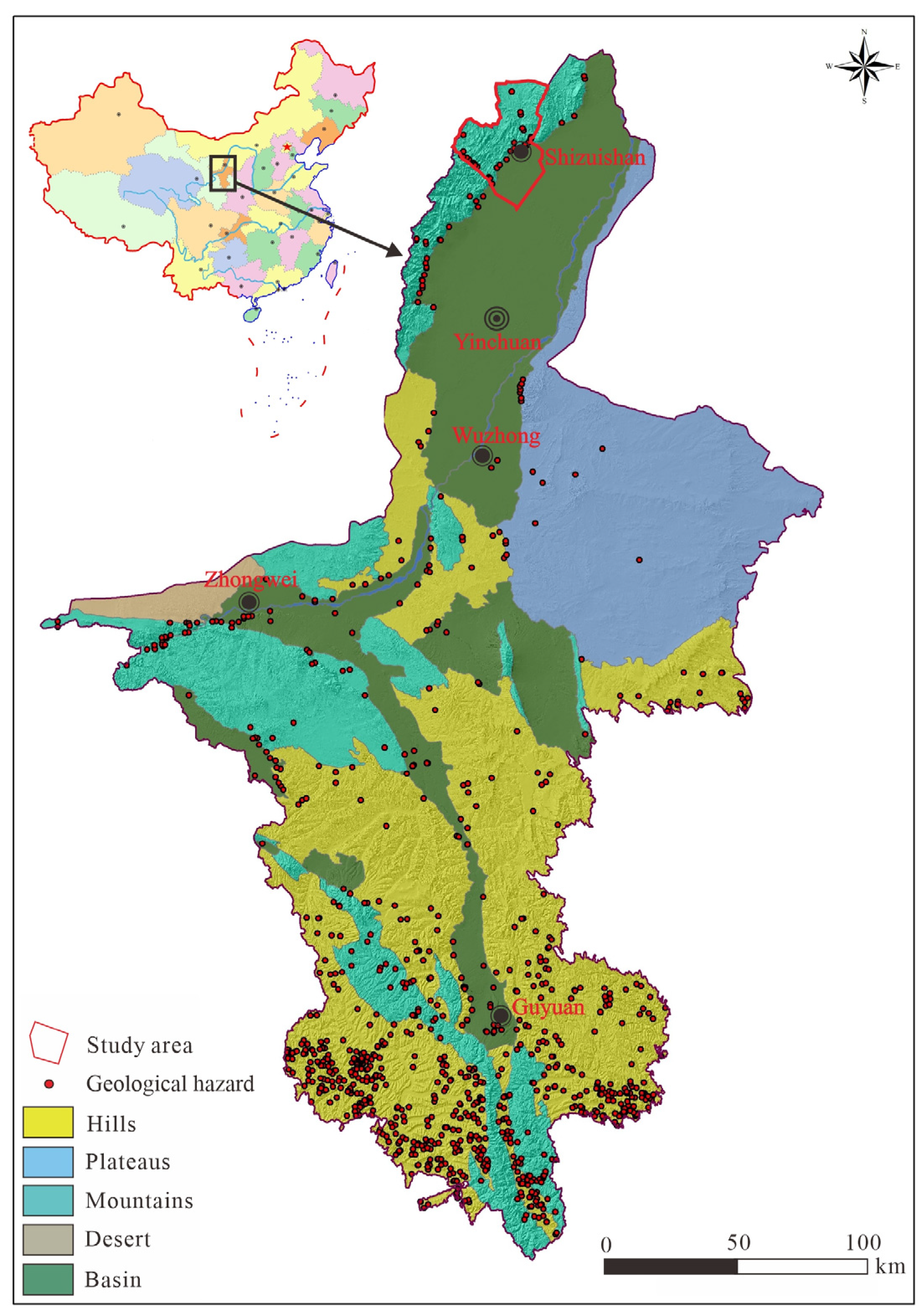
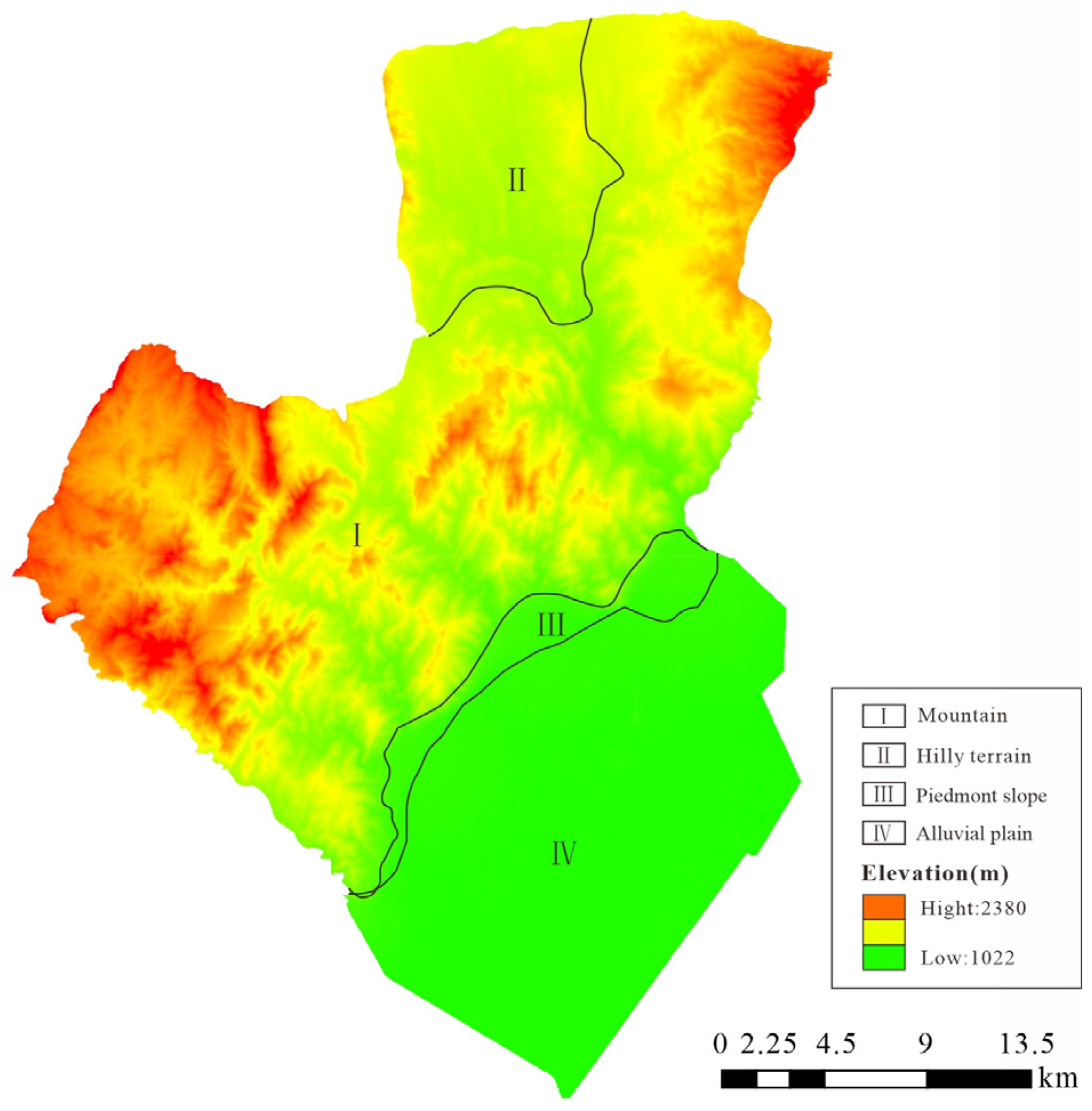
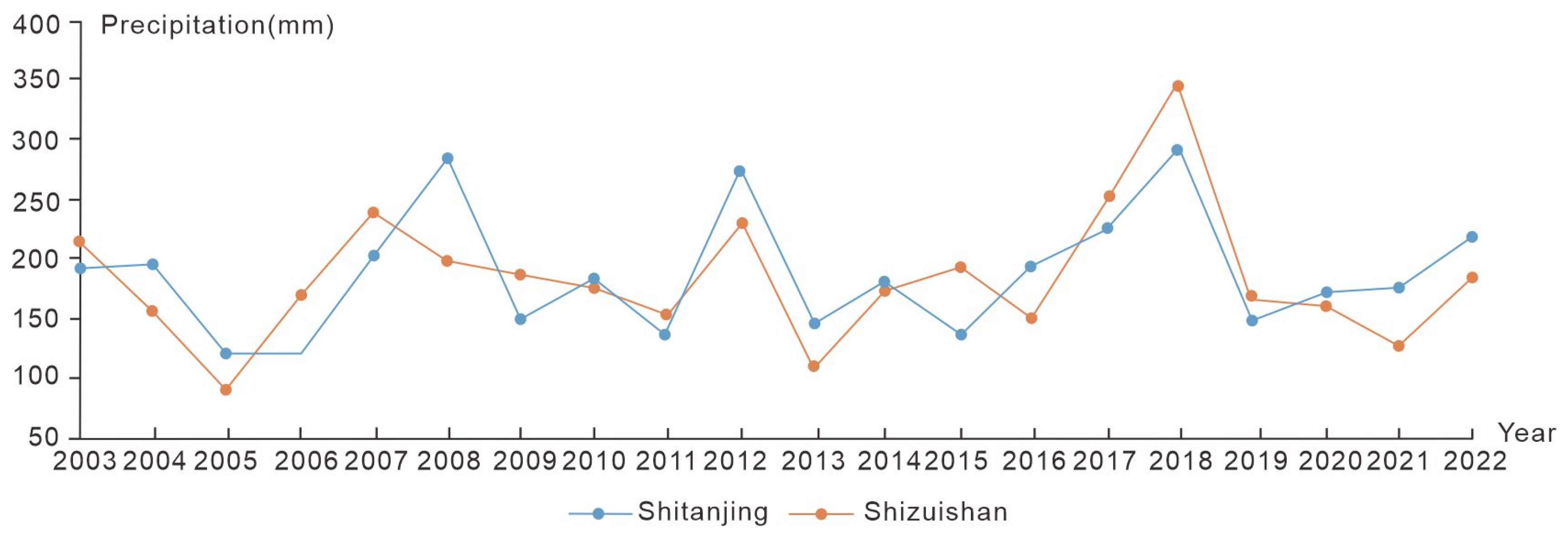
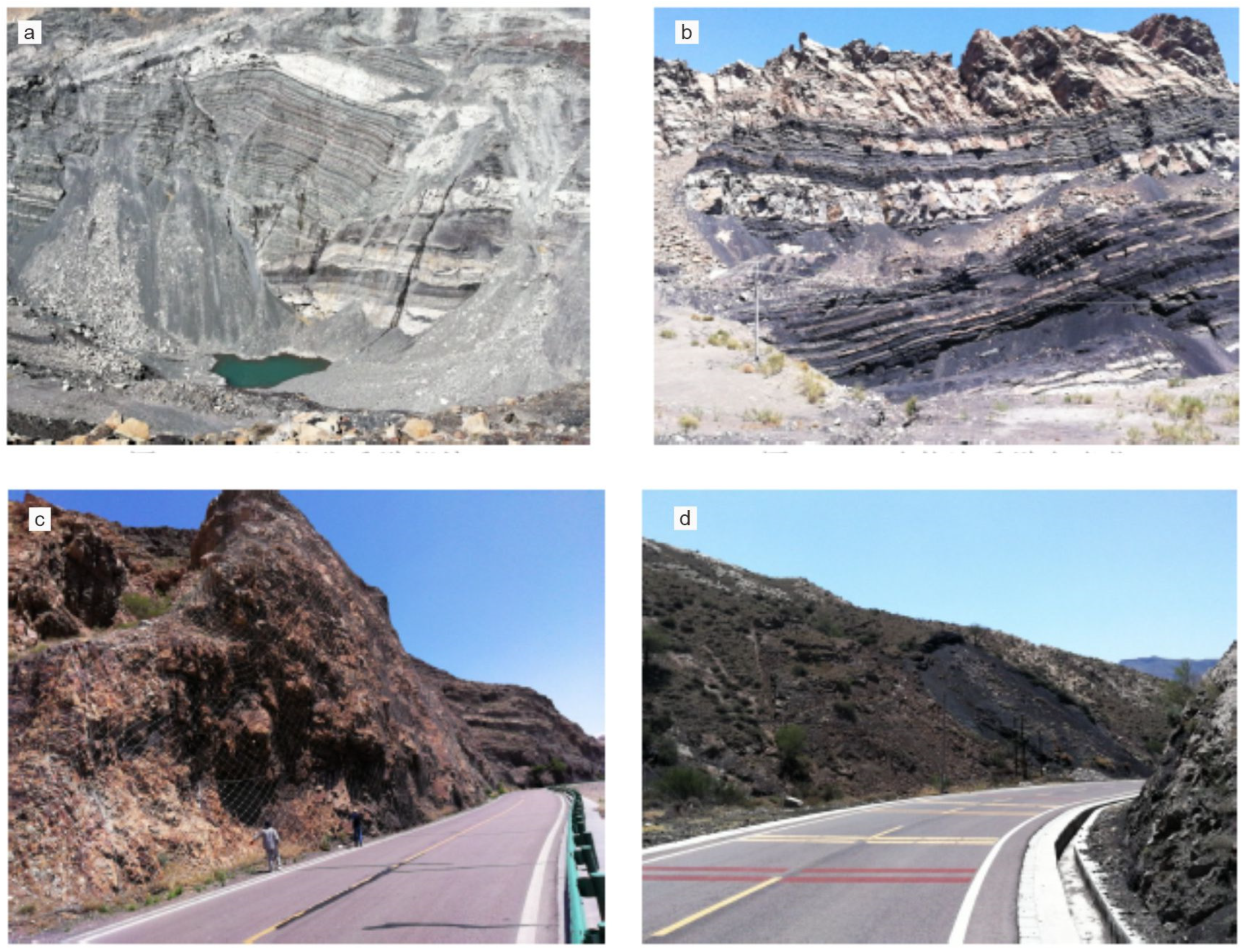
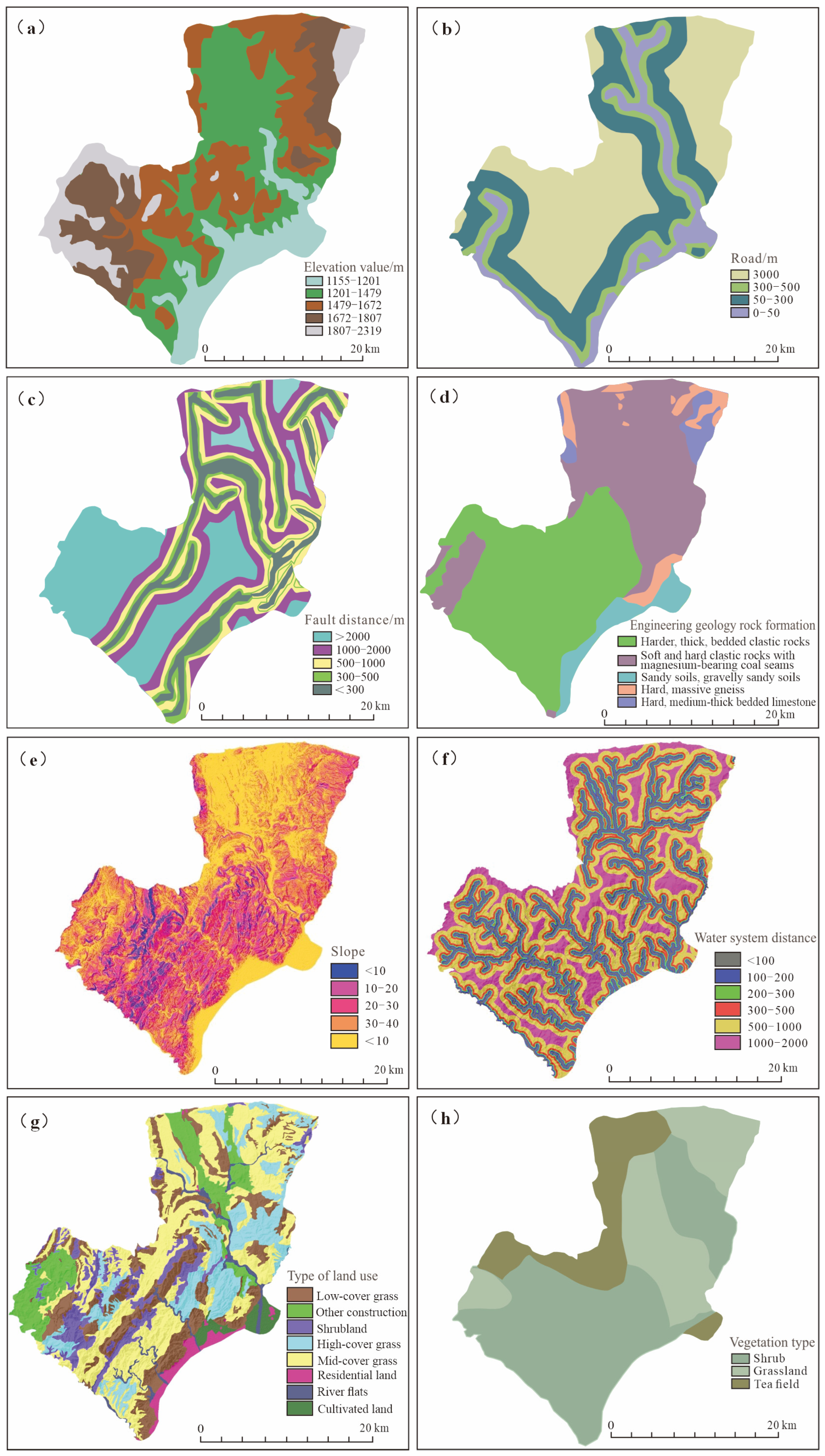

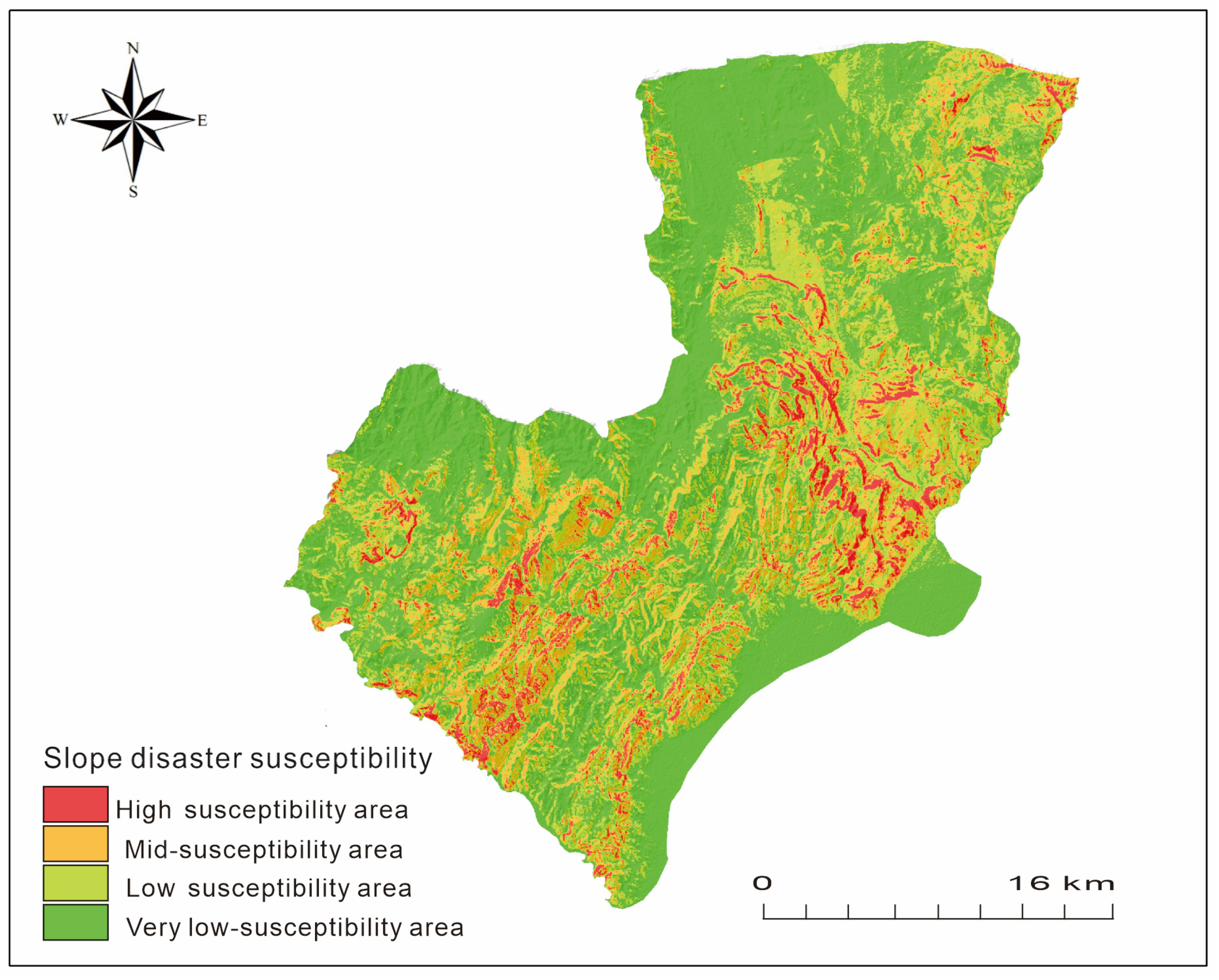
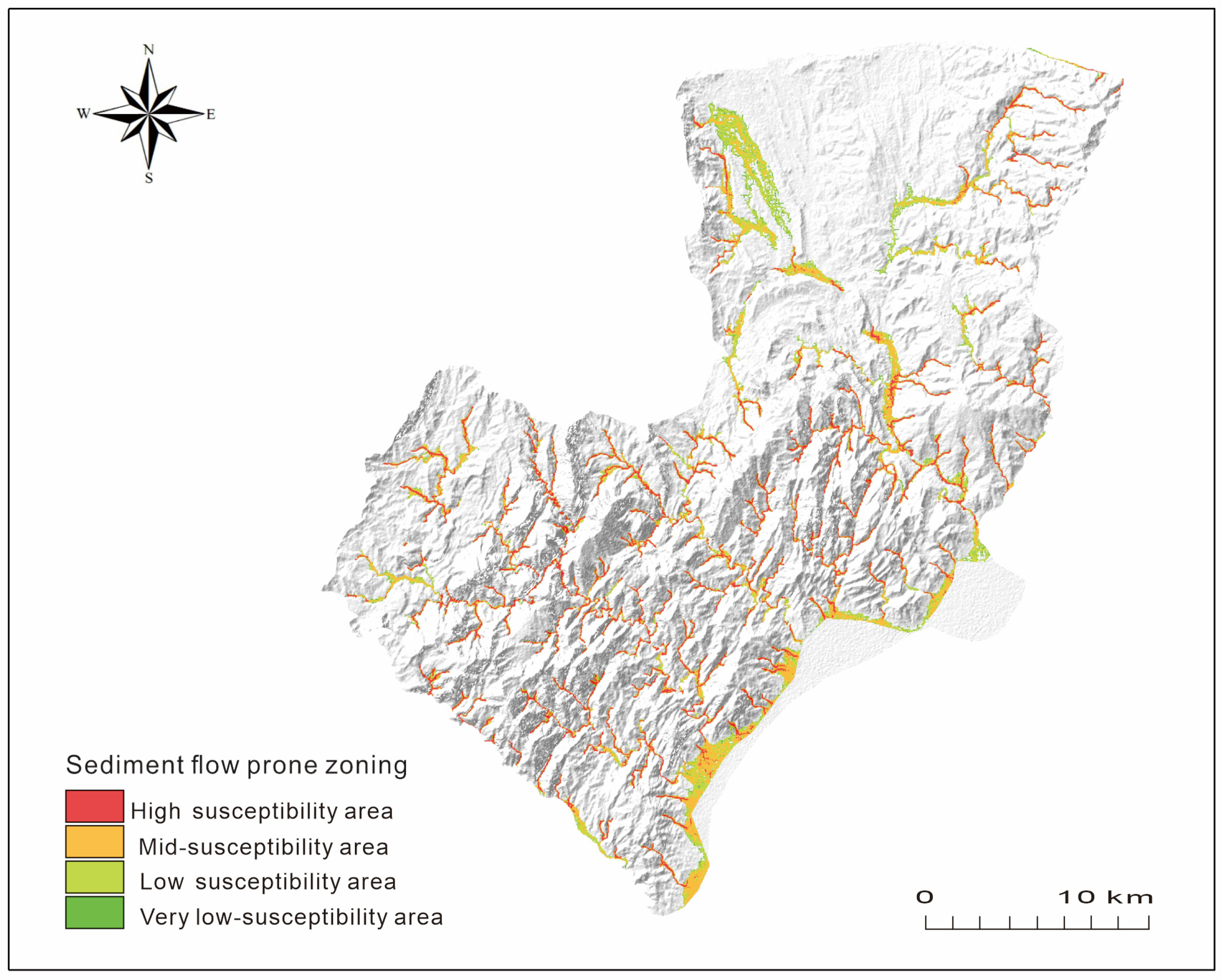
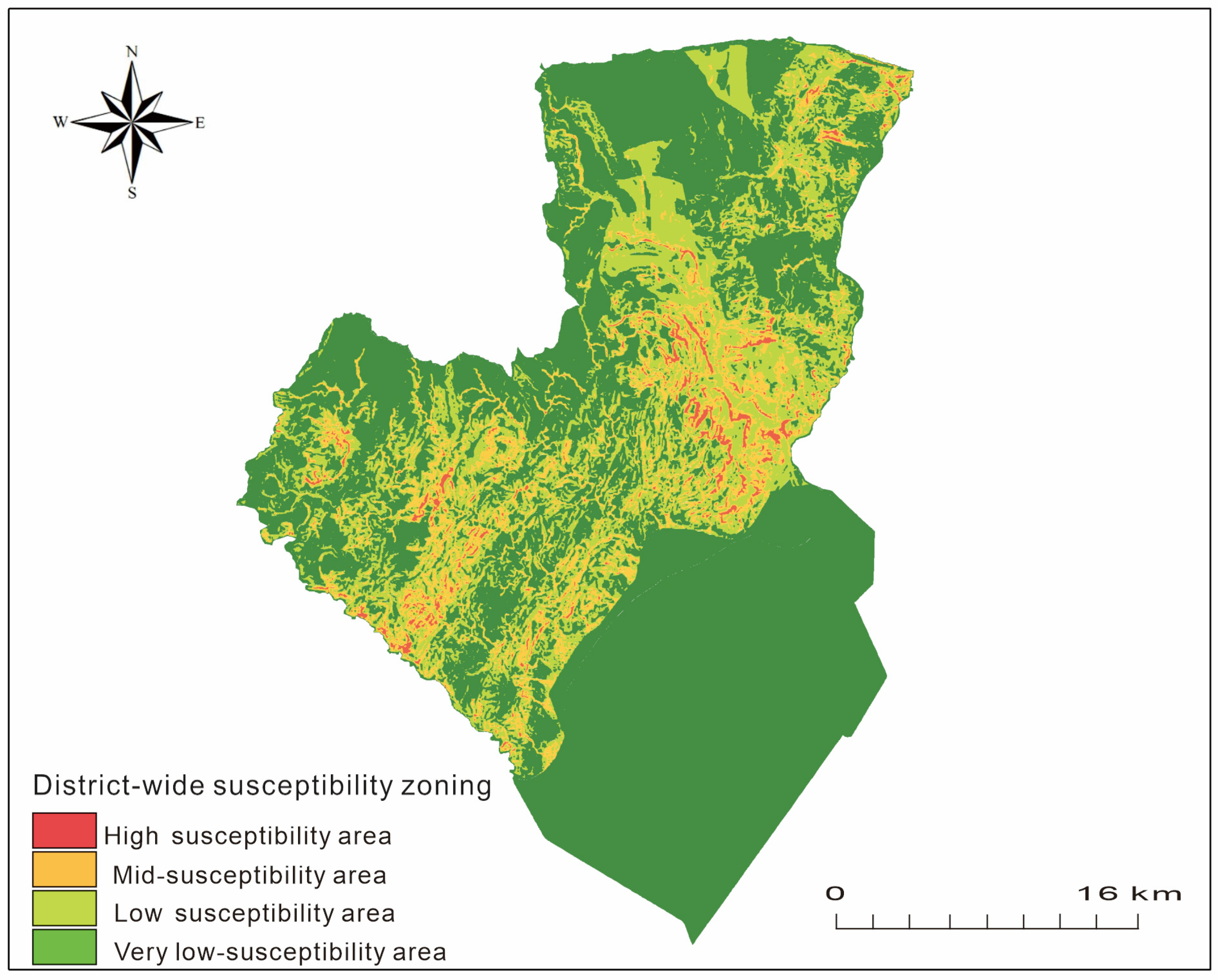
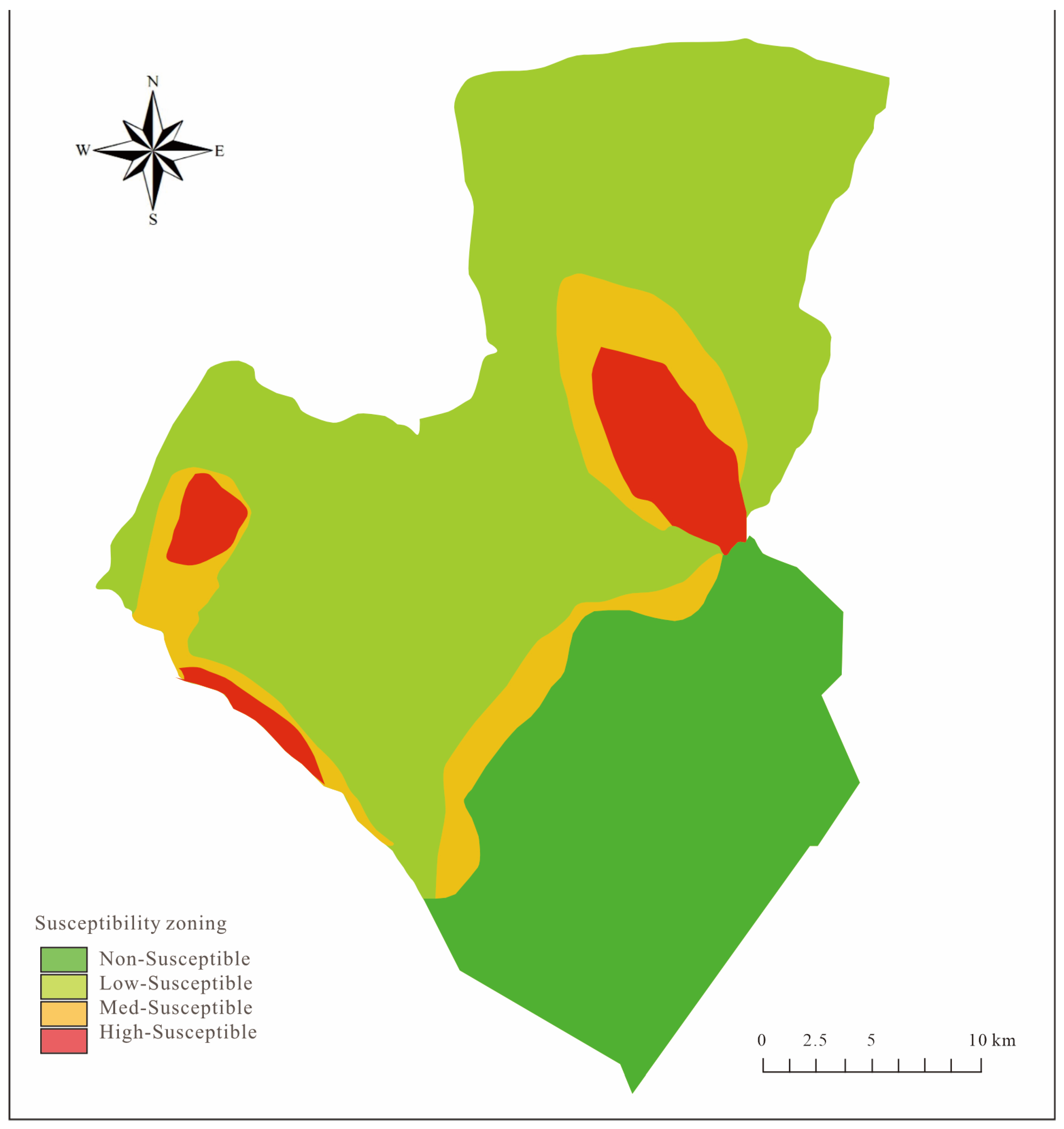
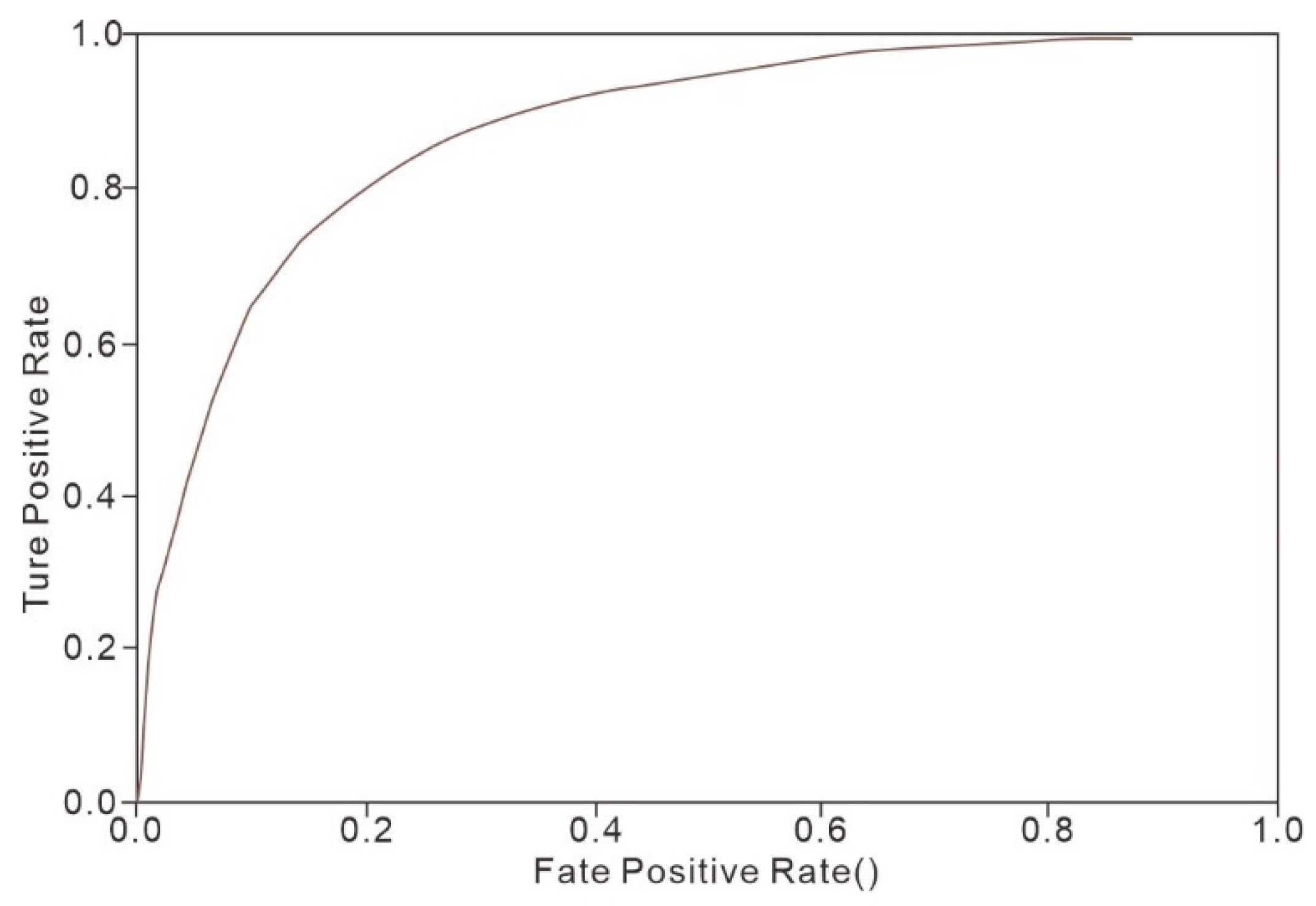
| Data | Data Sources | Data Type | Influence Factors | Temporal Coverage | Used in Susceptibility Analysis |
|---|---|---|---|---|---|
| Geological data | Field investigation | “shp” | Geomorphic type, rock and soil type, distance from fault zone | ~2015 (latest edition) | Yes |
| ASTER GDEM 30 m DEM | www.gscloud.cn (accessed on 16 May 2025) | “tiff” | Slope, aspect | 2011 (global release) | Yes |
| Landsat-8 satellite imagery | www.gscloud.cn (accessed on 16 May 2025) | “tiff” | NDVI | 2022 (Landsat-8 OLI, spatial resolution 30 m, temporal resolution single cloud-free composite with cloud masking applied) | Yes |
| PGA distribution map | earthquake.usgs.gov/earthquakes (accessed on 2 June 2025) | “shp” | PGA | 2020 (regional dataset) | No |
| Meteorological data | data.cma.cn (accessed on 2 June 2025) | “excel” | Precipitation | 2003-2022 | Yes |
| National water system, road network, and residential area | OpenStreetMap (www.openstreetmap.org (accessed on 21 July 2024)) | “shp” | Water systems, buildings, transportation facilities | 2022 | Yes |
| Census data | www.stats.gov.cn (accessed on 14 October 2024) | “excel” | Population | 2020 | No |
| Serial Number | Evaluation Indicator | AUC Value |
|---|---|---|
| 1 | Slope | 0.89 |
| 2 | Elevation | 0.78 |
| 3 | Relief | 0.78 |
| 4 | Vegetation Type | 0.67 |
| 5 | Fault | 0.62 |
| 6 | Road | 0.59 |
| 7 | Engineering Geological Rock Group | 0.59 |
| 8 | Land Use Type | 0.58 |
| 9 | Water System | 0.54 |
| 10 | Aspect | 0.59 |
| 11 | Slope Pattern | 0.6 |
| 12 | Geomorphology | 0.56 |
| Evaluation Factor | Classification | Sensitivity Index | Wi+ | Wi− |
|---|---|---|---|---|
| Elevation (m) | 1065–1281 | 0.726699 | 0.661855 | −0.06484 |
| 1281–1479 | 0.96124 | 0.739696 | −0.22154 | |
| 1479–1672 | 0.906052 | 0.730933 | −0.17512 | |
| 1672–1897 | 1.112863 | 0.945873 | −0.16699 | |
| 1897–2379 | 0.054619 | 0.051531 | −0.00309 | |
| >3000 | −0.46073 | −0.27947 | 0.181257 | |
| Distance to Road (m) | 1000–3000 | −0.00175 | −0.0012 | 0.000554 |
| 500–1000 | −0.20345 | −0.18417 | 0.019278 | |
| 300–500 | 0.488875 | 0.460076 | −0.0288 | |
| 100–300 | 1.064461 | 0.971101 | −0.09336 | |
| 50–100 | 0.437799 | 0.429441 | −0.00836 | |
| 0–50 | 0.357383 | 0.349716 | −0.00767 | |
| <100 | 0.762351 | 0.70287 | −0.05948 | |
| Distance to Fault (m) | 100–200 | 0.608289 | 0.565124 | −0.04316 |
| 200–300 | 0.254975 | 0.240331 | −0.01464 | |
| 300–500 | 0.04407 | 0.039813 | −0.00426 | |
| 500–1000 | −0.07506 | −0.06141 | 0.013648 | |
| 1000–2000 | 0.35921 | 0.258763 | −0.10045 | |
| >2000 | −1.02022 | −0.79424 | 0.22598 | |
| Engineering Geological Rock Group | Hard massive gneiss | 0.978652 | 0.912387 | −0.06626 |
| Hard medium-thick bedded limestone | −1.33963 | −1.31343 | 0.026195 | |
| Relatively hard thick-bedded clastic rock | −0.40932 | −0.22697 | 0.18235 | |
| Gravelly soil, sandy gravelly soil | −0.05611 | 0 | 0.056109 | |
| Soft–hard identical clastic rock coal-bearing strata | 0.489274 | 0.277918 | −0.21136 | |
| Slope (°) | 0–10 | −0.98959 | −0.88484 | 0.104752 |
| 10–20 | −0.11099 | −0.09468 | 0.016312 | |
| 20–30 | 1.167611 | 0.946997 | −0.22061 | |
| 30–40 | 2.260242 | 1.921598 | −0.33864 | |
| >40 | 2.580148 | 2.391511 | −0.18864 | |
| Relief (m) | 0–30 | −2.11513 | −1.63861 | 0.476523 |
| 30–60 | −0.55116 | −0.3814 | 0.169764 | |
| 60–90 | 1.26335 | 0.942813 | −0.32054 | |
| 90–120 | 1.897415 | 1.697911 | −0.1995 | |
| 120–258 | 1.769206 | 1.7098 | −0.05941 | |
| Distance to Water System (m) | <100 | −0.13425 | −0.11913 | 0.015116 |
| 100–200 | 0.250581 | 0.219616 | −0.03096 | |
| 200–300 | 0.204476 | 0.181768 | −0.02271 | |
| 300–500 | 0.164912 | 0.133133 | −0.03178 | |
| 500–1000 | −0.22058 | −0.1533 | 0.067282 | |
| 1000–2000 | −0.09859 | −0.08344 | 0.015144 | |
| Land Use Type | Low-coverage grass | −0.10073 | −0.08148 | 0.019252 |
| Other construction | 0.755062 | 0.636762 | −0.1183 | |
| Shrub forest land | −0.53746 | −0.4981 | 0.039355 | |
| High-coverage grass | 0.135142 | 0.112031 | −0.02311 | |
| Medium-coverage grass | −0.2058 | −0.13634 | 0.069462 | |
| Residential land | −1.29313 | −1.27665 | 0.016479 | |
| River beach land | 0.474279 | 0.456032 | −0.01825 | |
| Cultivated land | −0.02186 | 0 | 0.021864 | |
| Vegetation Type | Grassland | 1.124628 | 0.659991 | −0.46464 |
| Desert | −2.47812 | −2.29376 | 0.184354 | |
| Shrubbery | −0.40466 | −0.2099 | 0.194754 |
| Susceptibility | Area (km2) | Proportion |
|---|---|---|
| Very-low-susceptible area | 618.61 | 64.97% |
| Low-susceptible area | 222.06 | 23.32% |
| Moderate-susceptible area | 96.71 | 10.16% |
| High-susceptible area | 14.78 | 1.55% |
| Total | 948.84 | 100.00% |
Disclaimer/Publisher’s Note: The statements, opinions and data contained in all publications are solely those of the individual author(s) and contributor(s) and not of MDPI and/or the editor(s). MDPI and/or the editor(s) disclaim responsibility for any injury to people or property resulting from any ideas, methods, instructions or products referred to in the content. |
© 2025 by the authors. Licensee MDPI, Basel, Switzerland. This article is an open access article distributed under the terms and conditions of the Creative Commons Attribution (CC BY) license (https://creativecommons.org/licenses/by/4.0/).
Share and Cite
Gong, Y.; Gao, S.; Zhang, G.; Wang, G.; He, Z.; Hu, Z.; Wang, H.; He, X.; Zhang, Y. Risk Assessment of Geological Hazards in Dawukou, Shizuishan City Based on the Information Value Model. Sustainability 2025, 17, 5990. https://doi.org/10.3390/su17135990
Gong Y, Gao S, Zhang G, Wang G, He Z, Hu Z, Wang H, He X, Zhang Y. Risk Assessment of Geological Hazards in Dawukou, Shizuishan City Based on the Information Value Model. Sustainability. 2025; 17(13):5990. https://doi.org/10.3390/su17135990
Chicago/Turabian StyleGong, Yongfeng, Shichang Gao, Gang Zhang, Guorui Wang, Zheng He, Zhiyong Hu, Hui Wang, Xiaofeng He, and Yaoyao Zhang. 2025. "Risk Assessment of Geological Hazards in Dawukou, Shizuishan City Based on the Information Value Model" Sustainability 17, no. 13: 5990. https://doi.org/10.3390/su17135990
APA StyleGong, Y., Gao, S., Zhang, G., Wang, G., He, Z., Hu, Z., Wang, H., He, X., & Zhang, Y. (2025). Risk Assessment of Geological Hazards in Dawukou, Shizuishan City Based on the Information Value Model. Sustainability, 17(13), 5990. https://doi.org/10.3390/su17135990






